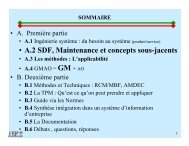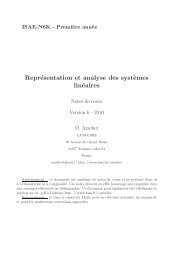Signaux aléatoires Cours 1 Introduction et rappels de ... - Laas
Signaux aléatoires Cours 1 Introduction et rappels de ... - Laas
Signaux aléatoires Cours 1 Introduction et rappels de ... - Laas
You also want an ePaper? Increase the reach of your titles
YUMPU automatically turns print PDFs into web optimized ePapers that Google loves.
▼ Définition 17 :<br />
Les signaux <strong>aléatoires</strong> : indépendance 40<br />
Soient {x(t) , t ∈ Tx} <strong>et</strong> {y(t) , t ∈ Ty} 2 processus stochastiques.<br />
x(t) <strong>et</strong> y(t) sont indépendants si {x(t1), ··· ,x(tn)} <strong>et</strong> {y(t1), ··· ,y(tm)} sont <strong>de</strong>s<br />
ensembles <strong>de</strong> vecteurs <strong>aléatoires</strong> indépendants pour toutes les partitions<br />
{t1, ··· ,tn} ∈ Tx <strong>et</strong> {t1, ··· ,tm} ∈ Ty<br />
Nota : vecteurs <strong>aléatoires</strong> indépendants<br />
Fx,y(α, β) =Fx(α)Fy(β) px,y(α, β) =px(α)py(β)<br />
E[f(x)g(y)] = E[f(x)]E[g(y)] p x/y(α/β) =px(α)<br />
<strong>Signaux</strong> <strong>aléatoires</strong> INSA













